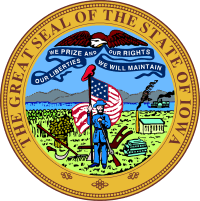Environment of Iowa
The ecology of the state of Iowa has been heavily affected by agricultural production, but remaining natural areas reflect a wide varieties of environmental niches.
Ecology and biota
Iowa's natural vegetation is tallgrass prairie and savanna in upland areas, with dense forest and wetlands in floodplains and protected river valleys, and pothole wetlands in northern prairie areas.[1] Most of Iowa is used for agriculture, crops cover 60% of the state, grasslands (mostly pasture and hay with some prairie and wetland) cover 30%, and forests cover 7%; urban areas and water cover another 1% each.[2]
Presettlement biota
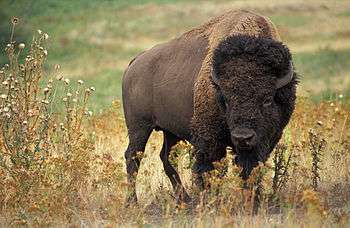
In 1840 Isaac Galland noted a large number of fauna in Iowa, including bison, elk, deer (either white-tailed deer or mule deer), raccoon, fox squirrel, mountain lion, lynx, gray wolf, black wolf, coyote (he called them prairie wolves), bear, beaver, otter, muskrat, mink, rabbits (presumably cottontail rabbit and hare), opossum, skunk, porcupine, groundhog, timber rattlesnake, prairie rattlesnake, bull snake, black snake, water moccasin, garter snake, water snakes, turkey, prairie chicken, quail, swan, geese, brant goose, duck, crane (he called them pelicans), crow, blackbird, bald eagle, "grey eagle" (probably a hawk or falcon), buzzard, raven, mourning dove, passenger pigeon, woodpeckers, woodcocks, hummingbird, and the honeybee.[3] Galland also included a list of edible flora readily available in Iowa, including strawberry, blackberry, raspberry, gooseberry, plum, crabapple, hickory nut, black walnut, butternut, hazelnut, pecan, grape, cherry, black haw, red haw, pawpaw, and cranberry.[3]
The first comprehensive listing of bird species in Iowa was compiled by Charles Rollin Keyes in 1889 which listed 262 species.[4] The first comprehensive listing of mammals in Iowa was made by Herbert Osborne in 1890.[5]
Natural Areas
There is a dearth of natural areas in Iowa; less than 1% of the tallgrass prairie that once covered most of Iowa remain intact, only about 5% of the state's prairie pothole wetlands remain, and most of the original forest has been lost.[6] Iowa ranks 49th of U.S. states in public land holdings.[7]
Threatened and endangered species
As of 2016, the U.S. Fish and Wildlife Service the lists of threatened and endangered species in Iowa have included the following:[8]
Federally endangered animal species:
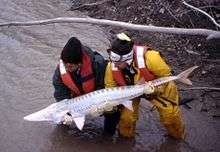
- Indiana bat (Myotis sodalis)
- Higgins eye pearly mussel (Lampsilis higginsii)
- Topeka shiner (Notropis topeka)
- Iowa Pleistocene snail (Discus macclintocki)
- Pallid sturgeon (Scaphirhynchus albus)
- Least interior tern (Sterna antillarum)
- Sheepnose Mussel (Plethobasus cyphyus)
- Spectaclecase (mussel) (Cumberlandia monodonta)
- Poweshiek Skipperling, (Oarisma poweshiek)
(3 more since 2010}
Federally threatened animal species:
- Piping plover (Charadrius melodus), except Great Lakes watershed
- Northern long-eared bat (Myotis septentrionalis)
- Skipper, Dakota (Hesperia dacotae)
Extirpated federally endangered animal species:
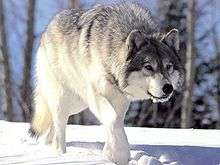
Locally extinguished animals are:
- American burying beetle (Nicrophorus americanus)
- Winged mapleleaf mussel (Quadrula fragosa)
- Scaleshell mussel (Leptodea leptodon)
- Orange-footed pimpleback mussel (Plethobasus cooperianus)
- Fat pocketbook pearly mussel (Potamilus capax)
- Gray wolf (Canis lupus)*
- Gray western Great Lakes wolf (Canis lupus)
- Bat, Indiana Entire (Myotis sodalis)
-* Note: Wolves occasionally reappear in Iowa, roaming south from home ranges in Minnesota and Wisconsin.[9]
Federally threatened plant species:

- Prairie bush-clover (Lespedeza leptostachya)
- Mead's milkweed (Asclepias meadii)
- Northern wild monkshood (Aconitum noveboracense)
- Eastern prairie fringed orchid (Platanthera leucophaea)
- Western prairie fringed orchid (Platanthera praeclara)
Extinct animal species (historical):[9]

- Carolina parakeet (Conuropsis carolinensis)
- Passenger pigeon (Ectopistes migratorius)
Landforms and topography
Despite popular perception, Iowa is generally not flat; most of the state consists of rolling hills. Prior[10] divides Iowa into eight landforms based on glaciation, soils, topography, and river drainage:
- The Paleozoic plateau, also known as the Driftless Area, is a region of scenic, high relief landscapes includes such features as resistant, bluff-forming bedrock outcrops, deep V-shaped valleys, caves, springs, and sinkholes. Glacial deposits and loess are thin or absent over most of the region.
- The Des Moines lobe, a remnant of the extensive prairie wetlands that once covered the Des Moines Lobe. Often called the Prairie Pothole Region, the Des Moines Lobe was glaciated up until 12,000 years ago during the Wisconsin glaciation. The area is marked by rolling terrain and ridges. Historically, this area was peppered with small interconnected swamps, most of which were drained for farmland. The Iowa Great Lakes occur along the western edge of the Des Moines lobe.
- The southern Iowa drift plain covers most of the southern half of Iowa. This is probably the most familiar landscape to travelers, since most of Interstate 80 in Iowa runs through the SIDP. The classic Iowa landscape, consisting of rolling hills of Wisconsin-age loess on Illinoian (or earlier) till. The SIDP is some of the most productive agricultural land in the world.
- The Mississippi alluvial plain includes generally level areas of stream terraces, paleochannels, backwater sloughs, and oxbow lakes within the broad Mississippi River valley.
- The Loess Hills consist of very thick deposits of loess in far western Iowa deposited during the Wisconsin and Illinoian periods. Highly eroded, leaving stark, beautiful "golden hills.
- The Iowan surface in northeast Iowa is covered with eroded Illinoian till with moderate loess formation, frequently in the form of paha ridges, muted relief except for steep rolling hills near river valleys, and deeper valleys. These picturesque hills are depicted in many of the landscapes of Grant Wood.
- The northwest Iowa plains are rolling hills consisting of eroded soils developed since pre-Wisconsinan glaciation, but with significant amounts of loess.
- The Missouri alluvial plain is perhaps the only truly flat region of Iowa, the Missouri Alluvial Plain contains areas of terraces, sloughs, and oxbows. Its valley trench is not as deep as the Mississippi River system, and the Missouri River is contained in a much narrower channel. In Iowa, the eastern border of the Missouri Plains is the Loess Hills, forming steep rounded bluffs.
Gallery of Iowa landforms
 Landforms of Iowa, based on Prior (1991)
Landforms of Iowa, based on Prior (1991)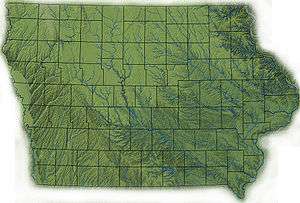 Topography of Iowa, with counties and major streams
Topography of Iowa, with counties and major streams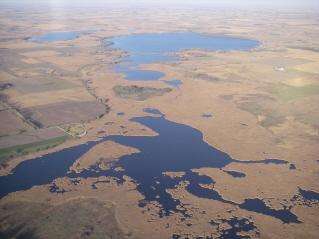 Barringer Slough, part of the Des Moines lobe
Barringer Slough, part of the Des Moines lobe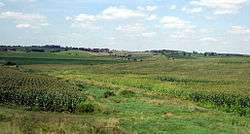 Typical view of the Southern Iowa Drift Plain
Typical view of the Southern Iowa Drift Plain Mississippi valley wetland near Ft. Madison
Mississippi valley wetland near Ft. Madison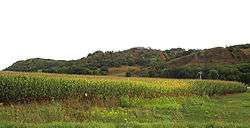 Loess Hills east of Mondamin, Iowa, showing the transition with the Missouri alluvial plain.
Loess Hills east of Mondamin, Iowa, showing the transition with the Missouri alluvial plain. Mississippi River alluvial plain from SIDP bluffs north of Kingston.
Mississippi River alluvial plain from SIDP bluffs north of Kingston.
Water

As in most of the U.S., surface water in Iowa is not safe to drink untreated, contamination by agricultural runoff including nitrates, herbicides, pesticides, and animal waste is common. Municipal water supplies are typically heavily chlorinated, this chlorine, combined with high nitrate levels, often give municipal water a strong smell, and the limestone bedrock in much of the state causes hard water.[11]
Some communities, such as Iowa City resort to additional carbon filtration and lime softening coagulation-sedimentation to make the water more palatable.[12] Water treatment is effective but comes at a price; while the Des Moines' advanced filtration system has led to water quality ranked among the nation's best.[13] In January 2015 the Des Moines Water Works "sued drainage districts in three northern Iowa counties, claiming the tiles there act as a conduit that accelerates the movement of fertilizer from farm fields into Iowa waterways".[14] Between 2010 and 2015 more than 60 Iowa cities and towns had high nitrate levels in drinking water.[14]
In 2015, there were a record number of beach closures because of harmful algal bloom in Iowa.[15]
Floods

Major flood events occurred in Iowa in 1851, 1892, 1965, 1993, 2008. The Great flood of 1851 hit all of Iowa, and almost destroyed the nascent town of Des Moines. "The Des Moines and Raccoon rivers rose to an unprecedented height, inundating the entire country east of the Des Moines river. Crops were utterly destroyed, houses and fences swept away."[16] After the town of Dudley was destroyed, survivors moved to higher ground and founded Carlisle. The flood of 1851 produced record levels on the Iowa River at Iowa City and the Cedar River at Cedar Rapids that stood until the Iowa flood of 2008.[17] The flash flood of 1892 destroyed much of Sioux City.[18] The Flood of 1965 affected eastern Iowa, from Cedar Rapids to Dubuque, with cities along the Mississippi hardest hit. The 1993 floods were widespread across the upper Midwest, causing extensive damage to Coralville and Iowa City.
Soils
The Natural Resources Conservation Service divides Iowa into 23 soil regions. In general, soils of southern, eastern, and western Iowa are loess-derived, while soils of northern and central Iowa are till-derived. Most level areas of Iowa have soils highly suitable for agriculture, making Iowa one of the most productive farming regions of the world.[19]
Pollution
The explosion in the number of high-density livestock facilities in Iowa has led to increased risk of rural water contamination and a perceived decline in air quality.[20] Other factors negatively affecting Iowa's environment include the extensive use of older coal-fired power plants,[21] fertilizer and pesticide runoff from crop production,.[22]
Jordan Aquifer
The Jordan Aquifer is the largest source of groundwater, extending from northeast Iowa to south central Iowa, and is the source of much of Iowa's agricultural and industrial water. Besides pollution, the aquifer is threatened by overuse in well-source irrigation, ethanol production, and decreased replenishment caused by extensive field tilling. The aquifer has dropped by as much as 300 feet since the 19th century, resulting in dry wells, disappearance of natural surface springs, and decrease of water quality.[23][24]
Climate statistics for selected cities
| Climate data for Des Moines International Airport, Iowa (1981–2010 normals,[lower-alpha 1] extremes 1878–present[lower-alpha 2]) | |||||||||||||
|---|---|---|---|---|---|---|---|---|---|---|---|---|---|
| Month | Jan | Feb | Mar | Apr | May | Jun | Jul | Aug | Sep | Oct | Nov | Dec | Year |
| Record high °F (°C) | 67 (19) |
78 (26) |
91 (33) |
93 (34) |
105 (41) |
103 (39) |
110 (43) |
110 (43) |
101 (38) |
95 (35) |
82 (28) |
69 (21) |
110 (43) |
| Mean maximum °F (°C) | 53.1 (11.7) |
59.1 (15.1) |
75.0 (23.9) |
84.0 (28.9) |
87.6 (30.9) |
93.2 (34) |
96.3 (35.7) |
95.2 (35.1) |
90.4 (32.4) |
82.4 (28) |
69.1 (20.6) |
55.8 (13.2) |
97.8 (36.6) |
| Average high °F (°C) | 31.0 (−0.6) |
36.1 (2.3) |
49.0 (9.4) |
62.3 (16.8) |
72.4 (22.4) |
81.6 (27.6) |
85.7 (29.8) |
83.8 (28.8) |
76.1 (24.5) |
63.1 (17.3) |
47.9 (8.8) |
34.0 (1.1) |
60.4 (15.8) |
| Average low °F (°C) | 14.3 (−9.8) |
18.8 (−7.3) |
29.7 (−1.3) |
41.1 (5.1) |
52.2 (11.2) |
62.0 (16.7) |
66.8 (19.3) |
64.8 (18.2) |
55.2 (12.9) |
43.0 (6.1) |
30.5 (−0.8) |
18.0 (−7.8) |
41.5 (5.3) |
| Mean minimum °F (°C) | −7.8 (−22.1) |
−4.1 (−20.1) |
9.5 (−12.5) |
23.7 (−4.6) |
37.6 (3.1) |
49.1 (9.5) |
56.3 (13.5) |
53.5 (11.9) |
38.0 (3.3) |
26.2 (−3.2) |
12.4 (−10.9) |
−3.6 (−19.8) |
−12.8 (−24.9) |
| Record low °F (°C) | −30 (−34) |
−26 (−32) |
−22 (−30) |
9 (−13) |
26 (−3) |
37 (3) |
47 (8) |
40 (4) |
26 (−3) |
7 (−14) |
−10 (−23) |
−22 (−30) |
−30 (−34) |
| Average precipitation inches (mm) | 1.00 (25.4) |
1.28 (32.5) |
2.30 (58.4) |
3.86 (98) |
4.74 (120.4) |
4.94 (125.5) |
4.47 (113.5) |
4.13 (104.9) |
3.05 (77.5) |
2.64 (67.1) |
2.19 (55.6) |
1.42 (36.1) |
36.02 (914.9) |
| Average snowfall inches (cm) | 8.5 (21.6) |
7.9 (20.1) |
5.2 (13.2) |
1.8 (4.6) |
0 (0) |
0 (0) |
0 (0) |
0 (0) |
0 (0) |
0.4 (1) |
2.5 (6.4) |
9.0 (22.9) |
35.3 (89.7) |
| Average precipitation days (≥ 0.01 in) | 7.5 | 7.8 | 9.7 | 11.2 | 12.5 | 11.5 | 10.1 | 9.1 | 8.4 | 8.9 | 8.3 | 8.4 | 113.4 |
| Average snowy days (≥ 0.1 in) | 6.5 | 5.6 | 3.2 | 1.0 | 0 | 0 | 0 | 0 | 0 | 0.3 | 2.0 | 6.2 | 24.8 |
| Average relative humidity (%) | 71.0 | 71.3 | 67.9 | 63.2 | 63.0 | 64.8 | 67.7 | 70.0 | 70.9 | 66.5 | 71.0 | 74.6 | 68.5 |
| Mean monthly sunshine hours | 157.7 | 163.3 | 206.0 | 222.2 | 276.0 | 312.1 | 337.8 | 297.9 | 239.8 | 210.0 | 138.5 | 129.2 | 2,690.5 |
| Percent possible sunshine | 53 | 55 | 56 | 56 | 61 | 69 | 73 | 70 | 64 | 61 | 47 | 45 | 60 |
| Source: NOAA (relative humidity and sun 1961−1990)[25][26][27] | |||||||||||||
| Climate data for Quad Cities (Quad City International Airport), 1981–2010 normals, extremes 1871–present[lower-alpha 3] | |||||||||||||
|---|---|---|---|---|---|---|---|---|---|---|---|---|---|
| Month | Jan | Feb | Mar | Apr | May | Jun | Jul | Aug | Sep | Oct | Nov | Dec | Year |
| Record high °F (°C) | 69 (21) |
73 (23) |
88 (31) |
93 (34) |
104 (40) |
104 (40) |
111 (44) |
106 (41) |
100 (38) |
95 (35) |
80 (27) |
71 (22) |
111 (44) |
| Average high °F (°C) | 31.0 (−0.6) |
35.7 (2.1) |
48.8 (9.3) |
62.3 (16.8) |
72.9 (22.7) |
82.3 (27.9) |
85.8 (29.9) |
83.8 (28.8) |
76.8 (24.9) |
64.1 (17.8) |
49.2 (9.6) |
34.6 (1.4) |
60.6 (15.9) |
| Average low °F (°C) | 14.3 (−9.8) |
18.3 (−7.6) |
29.4 (−1.4) |
40.5 (4.7) |
50.7 (10.4) |
60.7 (15.9) |
65.0 (18.3) |
63.2 (17.3) |
53.9 (12.2) |
42.4 (5.8) |
30.9 (−0.6) |
18.6 (−7.4) |
40.7 (4.8) |
| Record low °F (°C) | −27 (−33) |
−28 (−33) |
−19 (−28) |
7 (−14) |
25 (−4) |
39 (4) |
46 (8) |
40 (4) |
24 (−4) |
11 (−12) |
−10 (−23) |
−24 (−31) |
−28 (−33) |
| Average precipitation inches (mm) | 1.49 (37.8) |
1.60 (40.6) |
2.86 (72.6) |
3.59 (91.2) |
4.32 (109.7) |
4.49 (114) |
4.29 (109) |
4.52 (114.8) |
3.09 (78.5) |
2.97 (75.4) |
2.56 (65) |
2.18 (55.4) |
37.96 (964.2) |
| Average snowfall inches (cm) | 9.4 (23.9) |
6.8 (17.3) |
4.0 (10.2) |
0.9 (2.3) |
0 (0) |
0 (0) |
0 (0) |
0 (0) |
0 (0) |
0 (0) |
1.2 (3) |
9.3 (23.6) |
31.6 (80.3) |
| Average precipitation days (≥ 0.01 in) | 8.8 | 8.3 | 10.1 | 11.0 | 11.7 | 10.5 | 9.8 | 9.8 | 8.2 | 9.1 | 9.8 | 10.0 | 117.1 |
| Average snowy days (≥ 0.1 in) | 7.1 | 5.6 | 3.2 | 0.7 | 0 | 0 | 0 | 0 | 0 | 0 | 1.7 | 6.8 | 25.1 |
| Average relative humidity (%) | 69.9 | 69.8 | 68.3 | 64.3 | 64.9 | 65.8 | 70.5 | 73.3 | 72.8 | 68.1 | 71.3 | 74.0 | 69.4 |
| Mean monthly sunshine hours | 148.1 | 153.8 | 180.5 | 210.1 | 255.1 | 284.6 | 301.9 | 271.4 | 222.0 | 192.9 | 121.7 | 113.9 | 2,456 |
| Percent possible sunshine | 50 | 52 | 49 | 53 | 57 | 63 | 66 | 63 | 59 | 56 | 41 | 40 | 55 |
| Source: NOAA (relative humidity and sun 1961−1990)[28][29][30] | |||||||||||||
| Climate data for Sioux City, Iowa (Sioux Gateway Airport), 1981–2010 normals, extremes 1889–present | |||||||||||||
|---|---|---|---|---|---|---|---|---|---|---|---|---|---|
| Month | Jan | Feb | Mar | Apr | May | Jun | Jul | Aug | Sep | Oct | Nov | Dec | Year |
| Record high °F (°C) | 71 (22) |
75 (24) |
91 (33) |
98 (37) |
106 (41) |
108 (42) |
111 (44) |
108 (42) |
103 (39) |
96 (36) |
82 (28) |
71 (22) |
111 (44) |
| Average high °F (°C) | 30.5 (−0.8) |
34.9 (1.6) |
47.5 (8.6) |
62.3 (16.8) |
73.0 (22.8) |
82.1 (27.8) |
85.5 (29.7) |
83.3 (28.5) |
76.2 (24.6) |
63.3 (17.4) |
46.4 (8) |
32.1 (0.1) |
59.8 (15.4) |
| Average low °F (°C) | 10.2 (−12.1) |
15.2 (−9.3) |
25.5 (−3.6) |
36.8 (2.7) |
48.7 (9.3) |
58.6 (14.8) |
63.2 (17.3) |
60.9 (16.1) |
50.6 (10.3) |
38.0 (3.3) |
25.2 (−3.8) |
13.0 (−10.6) |
37.2 (2.9) |
| Record low °F (°C) | −35 (−37) |
−31 (−35) |
−22 (−30) |
−2 (−19) |
23 (−5) |
38 (3) |
41 (5) |
37 (3) |
24 (−4) |
5 (−15) |
−9 (−23) |
−28 (−33) |
−35 (−37) |
| Average precipitation inches (mm) | 0.62 (15.7) |
0.67 (17) |
2.00 (50.8) |
2.95 (74.9) |
3.74 (95) |
3.89 (98.8) |
3.44 (87.4) |
3.23 (82) |
2.96 (75.2) |
2.13 (54.1) |
1.31 (33.3) |
0.80 (20.3) |
27.74 (704.6) |
| Average snowfall inches (cm) | 6.7 (17) |
6.6 (16.8) |
6.5 (16.5) |
1.8 (4.6) |
0 (0) |
0 (0) |
0 (0) |
0 (0) |
0 (0) |
1.0 (2.5) |
4.4 (11.2) |
7.8 (19.8) |
34.8 (88.4) |
| Average precipitation days (≥ 0.01 in) | 6.3 | 6.0 | 8.3 | 9.9 | 11.3 | 10.9 | 9.5 | 9.4 | 8.3 | 7.4 | 6.7 | 6.9 | 100.9 |
| Average snowy days (≥ 0.1 in) | 5.9 | 5.0 | 3.8 | 1.4 | 0 | 0 | 0 | 0 | 0 | 0.5 | 3.2 | 5.7 | 25.5 |
| Average relative humidity (%) | 72.2 | 72.4 | 69.7 | 61.6 | 62.3 | 65.5 | 69.2 | 72.0 | 70.8 | 66.2 | 72.3 | 75.9 | 69.2 |
| Mean monthly sunshine hours | 171.1 | 165.5 | 211.9 | 232.3 | 271.8 | 310.2 | 330.9 | 292.9 | 235.5 | 209.3 | 146.4 | 138.3 | 2,716.1 |
| Percent possible sunshine | 58 | 56 | 57 | 58 | 60 | 68 | 71 | 68 | 63 | 61 | 50 | 49 | 61 |
| Source: NOAA (relative humidity and sun 1961–1990)[31][29][30], The Weather Channel[32] | |||||||||||||
Notes
- ↑ Mean monthly maxima and minima (i.e. the expected highest and lowest temperature readings at any point during the year or given month) calculated based on data at said location from 1981 to 2010.
- ↑ Official records for Des Moines kept August 1878 to August 1939 at downtown and at Des Moines Int'l since September 1939. For more information, see Threadex
- ↑ Official precipitation records for the Quad Cities kept at the Weather Bureau Office (WBO) in Davenport, Iowa from July 1871 to December 1931, alternating between Quad City Int'l (KMLI) and the Davenport WBO from January 1932 to 17 February 1937, and remaining at KMLI since 18 February 1937. Temperature, snowfall, and snow depth records date to 1 January 1874, 1 August 1882, and 1 January 1901, respectively. For more information, see Threadex
References
- ↑ Prior, Jean C. (1991) Landforms of Iowa. University of Iowa Press, Iowa City.
- ↑ Iowa DNR: Iowa's Statewide Land Cover Inventory, http://www.igsb.uiowa.edu/Browse/landcvr/landcvr.htm
- 1 2 Galland, Isaac (1840). Galland's Iowa emigrant: containing a map, and general descriptions of Iowa. Chillicothe, Ohio: W. C. Jones.
- ↑ Charles R. Keyes and W. S. Williams, "Preliminary Annotated Catalogue of the Birds of Iowa", Proc. of the Davenport Academy of Natural Sciences, Vol. V, pp. 113-161. 1889
- ↑ OSBORNE, HERBERT. 1890. "Catalogue of the mammals of Iowa". Proc. Iowa Academy of Science 1: 41-44.
- ↑ Iowa's Threatened and Endangered Species Program, http://www.iowadnr.gov/other/threatened.html
- ↑ Iowa Must Step Up Investment in Public Lands "Des Moines Register", June 1, 2005, http://www.nicholasjohnson.org/politics/IaChild/eddmr601.html
- ↑ "Species Reports: Listings and occurrences for Iowa". US Fish and Wildlife Service. Retrieved 13 August 2010.
- 1 2 Iowa DNR Iowa’s Wildlife Resource Base
- ↑ Prior, Jean C. (1991) Landforms of Iowa. University of Iowa Press, Iowa City. http://www.igsb.uiowa.edu/Browse/landform.htm. See also Calvin, Samuel (1904) Outline Map of the Drift Sheets of Iowa. Iowa Publication Co., Davenport.
- ↑ Iowa City Water Quality www.igsb.uiowa.edu
- ↑ http://www.icgov.org/default/?id=1623
- ↑ 'Drink up - from the city tap.' Des Moines Register 2 July 2008, http://www.desmoinesregister.com/apps/pbcs.dll/article?AID=/20080702/OPINION03/807020346/1110
- 1 2 Donnelle Eller (July 7, 2015). "High nitrate levels plague 60 Iowa cities, data show". Des Moines Register. Gannett. Retrieved 29 July 2015.
- ↑ Lindsey Moon , Ben Kieffer (7 June 2016). Boaters Beware: Iowa DNR Expects Another Record Year of Toxic, Blue Green Algae Blooms (Radio). Iowa City: Iowa Public Radio.
- ↑ Mills and Company (1866) 'Des Moines City Directory and Business Guide. Mills and Company, Des Moines Iowa, p. 6. Microfilm, State Historical Society Library, Iowa City.
- ↑ Maag, Christopher (13 June 2008). "In Eastern Iowa, the City That 'Would Never Flood' Goes 12 Feet Under". New York Times. Retrieved 19 July 2010.
- ↑ "Sioux City, IA flood, May 1892". Retrieved 19 July 2010.
- ↑ Information About Soils | Iowa NRCS
- ↑ "Living with Hogs in Rural Iowa". Iowa Ag Review. Iowa State University. 2003. Retrieved 25 November 2009.
- ↑ Heldt, Diane (November 24, 2009). "Report: Many Iowa coal plants among nation's oldest". Cedar Rapids Gazette. Retrieved 25 November 2009.
- ↑ "Iowa Works to Reduce Run-off Polluting the Gulf of Mexico". The Iowa Journal. Iowa Public Television. September 17, 2009. Retrieved 25 November 2009.
- ↑ Love, Orlan (Dec 6, 2009). "Heavy use draining aquifer". Cedar Rapids Gazette. Retrieved 20 December 2009.
- ↑ Tecklenburg, Jeff (Dec 18, 2009). "Don't take aquifer for granted". Cedar Rapids Gazette. Retrieved 20 December 2009.
- ↑ "NowData - NOAA Online Weather Data". National Oceanic and Atmospheric Administration. Retrieved 2012-01-06.
- ↑ "Station Name: IA DES MOINES INTL AP". National Oceanic and Atmospheric Administration. Retrieved 2016-09-12.
- ↑ "WMO Climate Normals for DES MOINES/MUNICIPAL, IA 1961–1990". National Oceanic and Atmospheric Administration. Retrieved 2014-03-10.
- ↑ "NowData - NOAA Online Weather Data". National Oceanic and Atmospheric Administration. Retrieved 2012-02-22.
- 1 2 "Station Name: IL MOLINE QUAD CITY INTL AP". National Oceanic and Atmospheric Administration. Retrieved 2014-04-05.
- 1 2 "WMO Climate Normals for MOLINE/QUAD CITY, IL 1961–1990". National Oceanic and Atmospheric Administration. Retrieved 2014-03-10.
- ↑ "NOWData - NOAA Online Weather Data". National Oceanic and Atmospheric Administration. Retrieved February 18, 2013.
- ↑ "Monthly Averages for Sioux Gateway Airport". The Weather Channel. Retrieved October 20, 2011.
External links
- Iowa Department of Natural Resources, http://www.iowadnr.gov/
- Iowa Natural Resources Conservation Services, http://www.ia.nrcs.usda.gov/
- Nature Conservancy Iowa, http://www.nature.org/wherewework/northamerica/states/iowa/news/campaign.html
- Iowa Geological Survey, http://www.igsb.uiowa.edu/
- Iowa Geographical Map Server, http://cairo.gis.iastate.edu/
- U.S. Geological Survey Iowa Overview, http://www.usgs.gov/state/state.asp?State=IA
- Geological Society of Iowa, http://www.iowageology.org/
